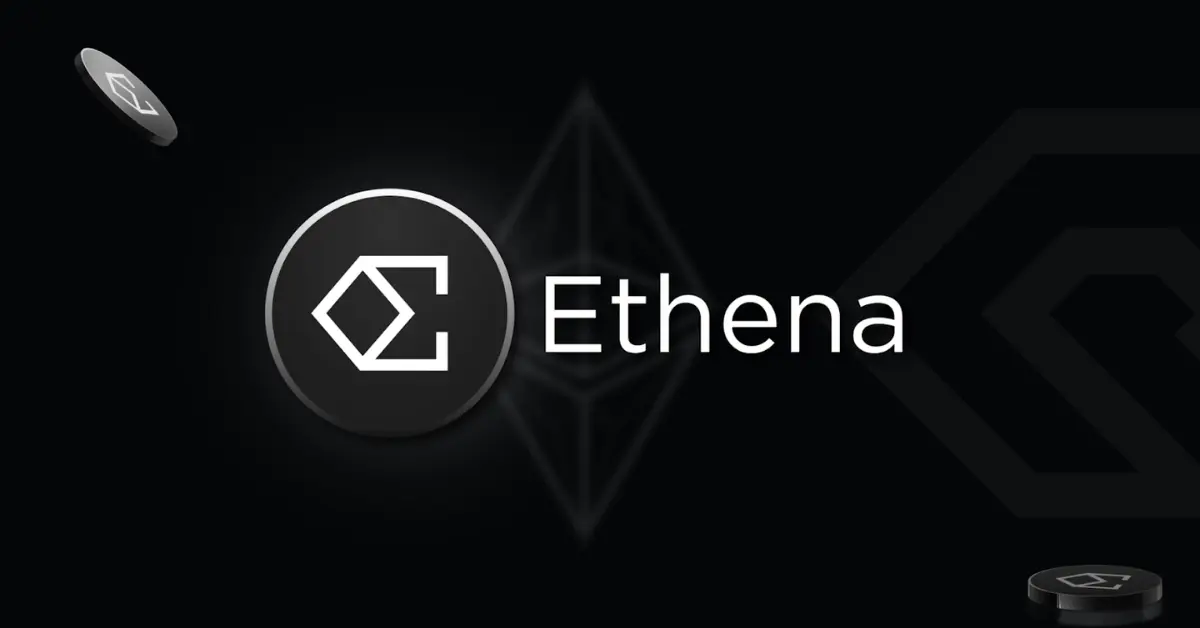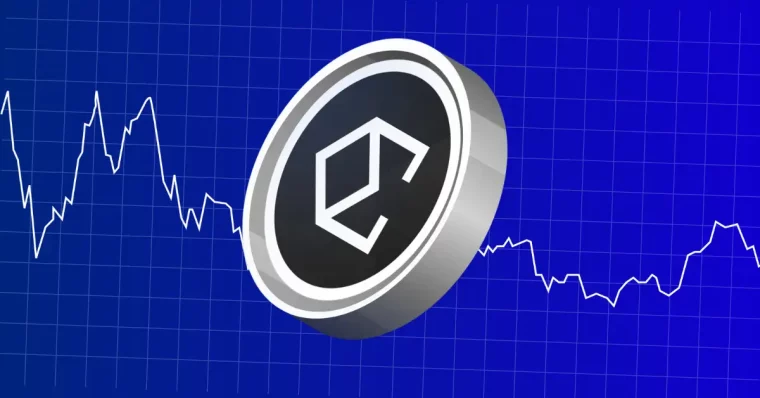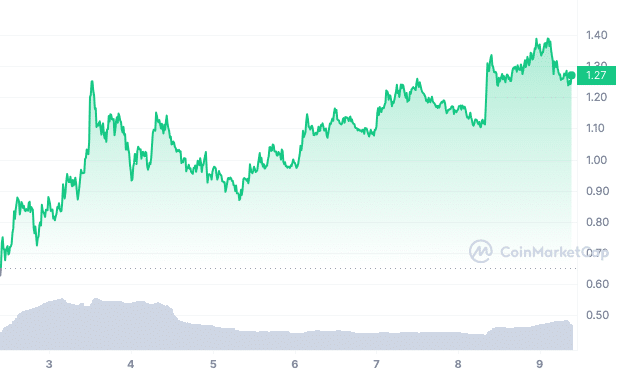In the ever-evolving world of cryptocurrency, an exciting new project has recently captured the attention and interest of the crypto community in a whirlwind of hype – Ethena (ENA) and its native stablecoin, USDe.
The project has captured the attention of the community by offering a staggering 37.1% APY on USDe staking
As the latest entrant into the stablecoin arena, Ethena is making waves with its unique approach to maintaining its peg to the US dollar but some investors are already fearing that it can turn into another LUNA – the stablecoin issued by Terra Labs that ultimately wiped billions of dollars from investors’ pockets in 2022.
In the past 7 days, the value of ENA – the native token of the Ethena protocol – has delivered gains of 92.3% to investors as the project’s total value locked (TVL) of USDe has skyrocketed to $2.25 billion according to DeFi Llama.
Key Highlights: Ethena’s Dual Stablecoin Strategy
- New Stablecoin Launch: Ethena introduced UStb, a traditional stablecoin backed by assets like USD and Treasuries, to complement its synthetic USDe.
- Market Response: ENA’s price surged by 45% following the UStb announcement, reflecting investor confidence.
- Risk Mitigation: UStb offers a safety net during periods of negative funding for USDe, which faces challenges with derivative-backed stability.
- Focus on Stability: Ethena’s dual approach aims to offer users diverse options for stablecoin holdings, catering to varying risk appetites.
- Latest Update: UStb is backed by BlackRock’s BUIDL fund. Unlike USDe, which relies on derivative strategies, UStb is fully backed by traditional financial assets, offering a more stable alternative.
Understanding Ethena and USDe
Ethena is a synthetic currency protocol built on the Ethereum blockchain that aims to provide a native cryptocurrency solution that is independent of traditional banking infrastructure.
Its flagship product, USDe, is a stablecoin that is committed to providing a stable, censorship-resistant digital currency that can scale by using Ethereum-staked assets as collateral.
Unlike other stablecoins that rely on fiat currency reserves or algorithmic mechanisms, USDe maintains its peg through the use of delta hedging derivative positions for the collateral assets held by the protocol.
Essentially, Ethena users can deposit assets like wrapped staked Ethereum (wstETH) onto the platform and, in return, Ethena mints USDe tokens to those users.
Ethena then uses this deposited wstETH as collateral to open short positions on Ethereum futures contracts on centralized exchanges, earning interest from funding rates. The theory behind this strategy is that the increased value of the wstETH should be offset by the decreased value of the short Ethereum position, creating a delta-neutral position and stabilizing the value of USDe.
Additionally, Ethena leverages the funding payments from its short Ethereum futures positions to generate yield for USDe holders, offering attractive annual percentage yields (APYs) of up to 40% as of today on the stablecoin as per DeFi Llama.
If you’re interested in diving into the gritty details of Ethena and its app, check out its full documentation page.
The Importance of Ethena’s Approach
Ethena’s approach to stablecoins addresses a critical issue in the cryptocurrency space. Many existing stablecoins still rely on traditional banking infrastructure and are susceptible to the influence of traditional financial institutions.
Ethena aims to provide a truly decentralized, crypto-native stablecoin that can serve as the foundation for a parallel financial system.
By using Ethereum staked assets as collateral and employing derivative strategies to maintain the peg, Ethena seeks to create a scalable and censorship-resistant stablecoin that can be freely utilized within the decentralized finance (DeFi) ecosystem. This is a significant step towards realizing the goal of building a truly decentralized financial system.
Preventing Depegging Incidents – Can ENA Suffer the Same Faith as Terra’s Luna?
One of the primary concerns around stablecoins is their ability to maintain their peg, as witnessed in the high-profile collapse of the Terra ecosystem, its stablecoin UST and its native token LUNA in 2022. If you are familiar with that catastrophe, Ethena’s backing mechanism may seem a bit intimidating.
But Ethena has implemented several mechanisms to mitigate the risk of depegging incidents on its USDe stablecoin.
First, the use of delta hedging through short Ethereum futures positions is designed to offset changes in the value of the collateral assets. This helps stabilize the value of USDe.
The protocol also maintains an insurance fund that can be deployed to top up margin accounts, offset negative funding yields, or act as a buyer of last resort for USDe on the open market.
Moreover, Ethena has taken steps to protect users’ collateral by utilizing off-exchange settlement (OES) solutions. This means that user funds are held with reputable third-party custodians, with only account balances mirrored onto centralized exchanges to provide trading margin. This approach helps minimize counterparty risks and ensures the safety of Ethena’s users’ assets.
While the protocol acknowledges the potential risks such as collateral depeg, funding rate fluctuations, and counterparty risk, Ethena has implemented transparency and contingency plans to address these concerns. The team’s willingness to openly discuss these risks sets Ethena apart from some of the previous stablecoin projects that faced collapse.
What the Crypto Community is Saying about Ethena
The introduction of Ethena and its USDe token has sparked a lively debate within the crypto community.
While some enthusiasts are excited about the project’s potential, others have raised concerns about its similarities to the ill-fated LUNA and Terra Labs algorithmic stablecoin Terra USD (UST).
André Cronje, the renowned decentralized finance (DeFi) developer and co-founder of Yearn Finance and Fantom, has expressed cautious skepticism about Ethena. In a recent tweet, Cronje highlighted the potential risks associated with Ethena’s delta hedging strategy.
Every so often we see something new in this space. I often find myself on the mid curve for an extensive amount of time. I am comfortable here. That being said, there have been events in this industry I wish I was more curious about, there have also been events I definitely did…
— Andre Cronje (@AndreCronjeTech) April 3, 2024
“So while things are going great now (because market is positive and shorting funding rates are positive [because everyone is happy being long]), eventually that turns, funding becomes negative, margin/collateral gets liquidated, and you have an unbacked asset”, the crypto entrepreneur highlighted in a lengthy X post.
However, not all industry figures share Cronje’s concerns. Arthur Hayes, the co-founder of BitMEX, has publicly stated that he believes Ethena’s design is superior to that of the collapsed Terra protocol. Hayes, an early-stage investor in Ethena, has praised the project’s approach to maintaining the USDe peg.
Meanwhile, Evgeny Gaevoy, the CEO of Wintermute, a leading digital asset market maker, has also expressed optimism about Ethena.
Gaevoy emphasizes that the protocol’s use of stETH and BTC as collateral sets it apart from previous unstable stablecoin projects, highlighting the potential for long-term resilience and success.
you are long stETH, short ETH perp (and use stETH as collateral for perp position). You cannot be liquidated. Key risks here are custody/execution related
— wishful cynic (@EvgenyGaevoy) April 3, 2024
Gaevoy argues that the risks of Ethena have nothing to do with liquidation but rather custody and execution.
Ideally, he says, you can’t be liquidated if you hold the same amount of long and short positions. The risk here is that the Ethena protocol might mess this up in its execution or its custody solution may fail in some way.
Investors Pile on ENA and Cause its Price to Surge Rapidly
Despite the ongoing debates, Ethena’s native token, ENA, has experienced a remarkable price surge since its launch. The token, which debuted at around $0.65, has nearly doubled its value as of today, reaching a market capitalization of $1.8 billion and placing it among the top 100 cryptocurrencies.
The recent airdrop of ENA tokens to Ethena users has further fueled investors’ interest, with the token price climbing to an all-time high of $1.39 on April 9th.
The protocol’s high-yield offerings, with APYs reaching as much as 40% on the USDe stablecoin, have proven to be a significant draw for investors seeking attractive returns in the current market environment.
Moreover, the protocol has seen a significant increase in its total value locked (TVL), rising by over 2,500% since the beginning of the year.
Excited to announce that Ethena has onboarded BTC as a backing asset to USDe
This is a crucial unlock which will enable USDe to scale significantly from the current $2bn supply pic.twitter.com/FOZRWBrVZV
— Ethena Labs (@ethena_labs) April 4, 2024
The addition of Bitcoin (BTC) as a backing asset for the USDe stablecoin (using the same strategy) has also been a strategic move by Ethena, aimed at enhancing the protocol’s scalability and creating a more robust backing for the stablecoin.
This diversification of collateral assets has further bolstered investor confidence in the project.
Bottom Line
Ethena and its USDe stablecoin have undoubtedly captured the attention of the crypto community with their unique approach to maintaining a dollar peg and the promise of high yields.
While the project has faced some criticism and comparisons to past failures, Ethena’s transparency, contingency planning, and the backing of prominent industry figures suggest that it may have the potential to become a significant player in the evolving stablecoin landscape.
As the crypto industry continues to evolve, the success or failure of Ethena will be closely watched as it represents a promising attempt to create a truly decentralized, crypto-native stablecoin that can serve as the foundation for a more robust, resilient, permissionless, and trustless financial system.


